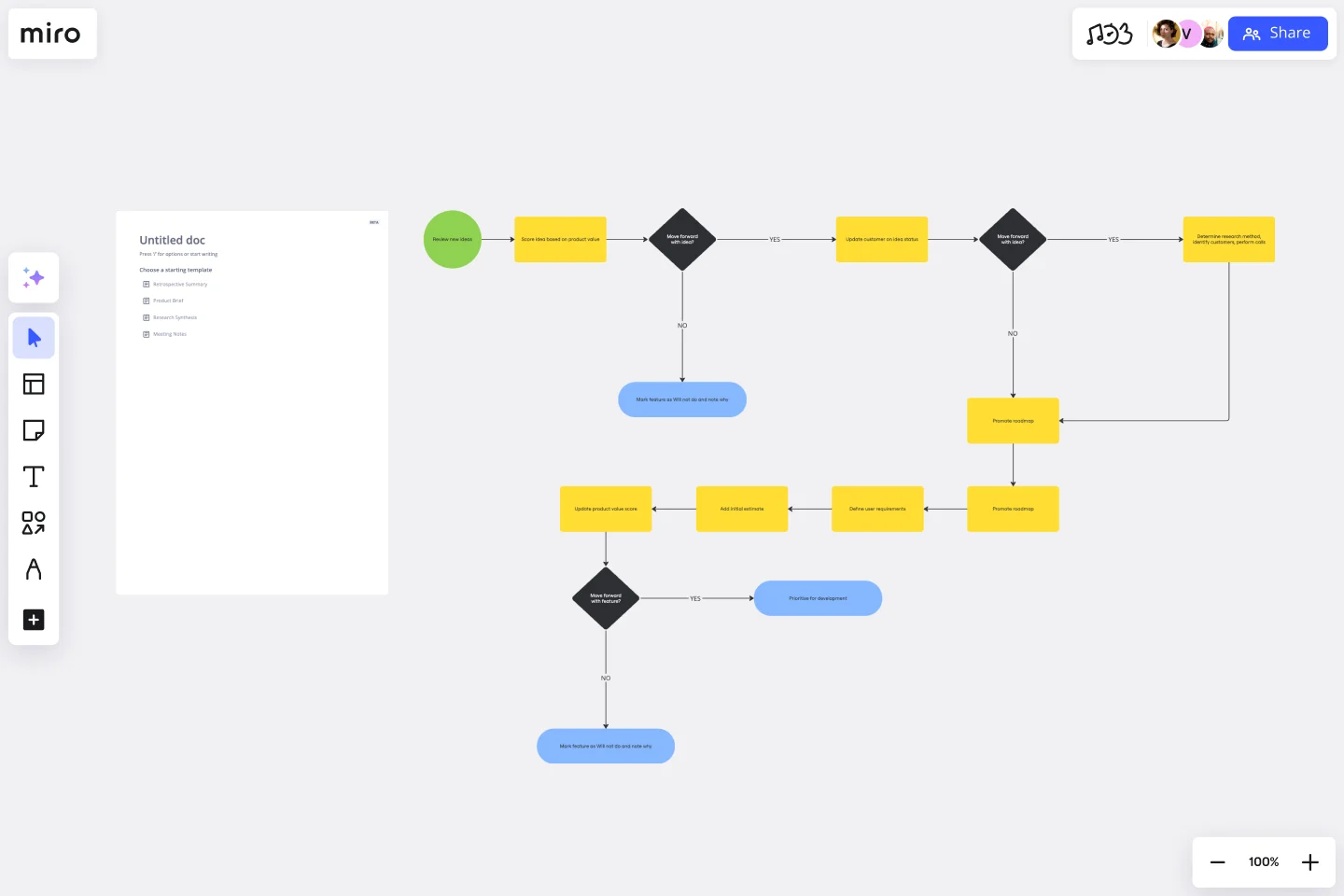Workflow Diagram Template
Bring clarity to teams with the workflow diagram template. By translating processes in a visual way, everyone gains a comprehensive understanding, reducing complexity and maximizing efficiency.
About the Workflow Diagram Template
When seeking clarity in processes, visual assets often come to the rescue. Enter the workflow diagram template. This tool is designed to streamline operations, elucidate roles, and illuminate the path from task initiation to completion. It's a bridge between mere ideas and actual, tangible results, ensuring seamless progress for projects of all scales.
Using standardized symbols and shapes, the workflow diagram template depicts a process's various steps or stages and the flow of tasks between them. This is crucial for understanding, analyzing, and optimizing processes to enhance efficiency and ensure clarity among all team members.
How to use the workflow diagram template?
1. Add the template
Select the template in the Templates Library.
2. Customize it
Tailor the template to your needs effortlessly. Add, remove, or rearrange stages and steps by clicking on the shapes and connection lines. Edit color, font, and shape size using the context menu bar above the shape.
3. Expand your workflow diagram
As your process grows or changes, click on the shapes to expand or adapt your diagram.
4. Embed artifacts
Enhance your workflow diagram by adding any required artifacts. Be it documents, images, links, or notes – integrate them by uploading via a link or with the drag and drop feature.
Why should you use a workflow diagram template?
Increase clarity and understanding: By visually representing tasks and the flow between them, everyone gets a clearer picture of what needs to be done and how.
Optimize processes: Visualizing a process can help identify redundancies, bottlenecks, and inefficiencies. Once identified, steps can be rearranged, removed, or streamlined as needed.
Promote consistency: A standardized process ensures that tasks are executed consistently, resulting in predictable outcomes.
Increase collaboration: By laying out the entire process, team members can see where their tasks fit into the bigger picture, fostering collaboration and unity.
Use as a training tool: For newcomers or those unfamiliar with the process, a visual workflow can act as a guide, helping them learn and understand their roles and responsibilities faster.
Using process mapping software can be a game changer when you need to connect teams, optimize business processes, and scale your organization. Also, discover more workflow diagram examples to propel your projects futher.
Is the template suitable for complex processes?
The template can be expanded and customized to cater to simple and complex processes. The automated diagram feature ensures that complexity doesn't interfere with clarity.
Can multiple team members work on the template simultaneously?
The platform supports real time collaboration, allowing multiple team members to edit, comment, and view the diagram simultaneously.
Can I integrate the workflow diagram with other tools?
Yes, the platform offers seamless integration capabilities, allowing you to link your workflow diagram with other tools and platforms you might be using, making it a central hub for all your process-related needs.
Get started with this template right now.
Cloudflare RAG Architecture Knowledge Queries Template
The Cloudflare RAG Architecture Knowledge Queries template is a cutting-edge tool designed to streamline the process of diagramming and understanding the intricate architecture of Cloudflare's Retrieval Augmented Generation (RAG) system. This template is a boon for teams aiming to visualize, query, and optimize Cloudflare's infrastructure collaboratively.
Communication Roadmap
Works best for:
Roadmap, Mapping, Planning
The Communication Roadmap template enables teams to plan and execute effective communication strategies. By outlining key messages, channels, and stakeholders, teams can ensure consistent and targeted communication throughout a project lifecycle. This template fosters alignment and transparency, enabling teams to engage stakeholders effectively and mitigate risks associated with miscommunication.
Customer Touchpoint Map Template
Works best for:
Desk Research, Product Management, Mapping
To attract and keep loyal customers, you have to truly start to understand them—their pain point, wants, and needs. A customer touchpoint map helps you gain that understanding by visualizing the path your customers follow, from signing up for a service, to using your site, to buying your product. And because no two customers are exactly alike, a CJM lets you plot out multiple pathways through your product. Soon you’ll be able to anticipate those pathways and satisfy your customers at every step.
Value Stream Mapping Template
Works best for:
Project Management, Strategic Planning, Mapping
A value stream map can help you refocus your business on steps that actually provide value to your customers, cutting out wasteful and inefficient processes. With this template, you and your process team can collaborate on a value stream map today.
Entity–Relationship Diagram (ERD) HR Management System Template
Works best for:
ERD
The Entity–Relationship Diagram (ERD) HR Management System Template in Miro is designed to streamline the management of employee-related information and processes within an organization. This template allows for the visualization and organization of complex HR systems, making it easier to understand relationships and processes. It enables users to map out departments, positions, and employee details, including attendance records, payroll, and performance reviews.
Incident Management Process Flowchart Template
The Incident Management Process Flowchart Template in Miro is designed to streamline and clarify the process of managing incidents within an organization. This template serves as a visual guide that outlines the steps involved in incident management, from the initial declaration to the final review. It is a living document, continuously evolving based on feedback and lessons learned from past incidents, ensuring that the process remains up-to-date with best practices. By defining incidents as disruptions requiring a coordinated response to restore service levels, the template emphasizes the importance of a structured, organized, and timely approach. It covers various phases such as Incident Declaration, Assessment, Response, Communication, and Review, providing a clear framework for teams to follow.
